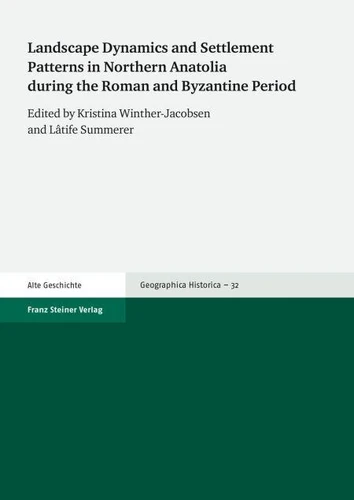Landscape Dynamics and Settlement Patterns in Northern Anatolia during the Roman and Byzantine Period
Par : ,Formats :
Disponible dans votre compte client Decitre ou Furet du Nord dès validation de votre commande. Le format PDF est :
- Compatible avec une lecture sur My Vivlio (smartphone, tablette, ordinateur)
- Compatible avec une lecture sur liseuses Vivlio
- Pour les liseuses autres que Vivlio, vous devez utiliser le logiciel Adobe Digital Edition. Non compatible avec la lecture sur les liseuses Kindle, Remarkable et Sony
 , qui est-ce ?
, qui est-ce ?Notre partenaire de plateforme de lecture numérique où vous retrouverez l'ensemble de vos ebooks gratuitement
Pour en savoir plus sur nos ebooks, consultez notre aide en ligne ici
- Nombre de pages354
- FormatPDF
- ISBN978-3-515-11216-1
- EAN9783515112161
- Date de parution17/12/2015
- Protection num.Digital Watermarking
- Taille16 Mo
- Infos supplémentairespdf
- ÉditeurFranz Steiner
Résumé
After his victory over Mithradates VI the Roman general Pompey founded a number of cities in order to shape the newly founded Roman province in the inland of the conquered former Pontic kingdom, in the southern Black Sea region. This sparked the beginning of an intense process of urban and rural development peaking in the 2nd century AD and continuing until the Byzantine period, a level of intensity never accomplished in northern Anatolia until today.
The reorganization of space through the development of new urban centers affected the whole region and transformed the territory. This volume reviews current knowledge regarding these new founded Roman cities in relation to their territories, necropoleis and sanctuaries. It consists of 18 articles, which explore dynamics in settlement patterns, architecture, urban and mortuary spaces, monetary circulation and epigraphic habit.
Some articles present the results of recent field research, others review little known material ripe for new interpretations, while new archaeological data is provided by the reports of rescue excavations carried out by local museums.
The reorganization of space through the development of new urban centers affected the whole region and transformed the territory. This volume reviews current knowledge regarding these new founded Roman cities in relation to their territories, necropoleis and sanctuaries. It consists of 18 articles, which explore dynamics in settlement patterns, architecture, urban and mortuary spaces, monetary circulation and epigraphic habit.
Some articles present the results of recent field research, others review little known material ripe for new interpretations, while new archaeological data is provided by the reports of rescue excavations carried out by local museums.
After his victory over Mithradates VI the Roman general Pompey founded a number of cities in order to shape the newly founded Roman province in the inland of the conquered former Pontic kingdom, in the southern Black Sea region. This sparked the beginning of an intense process of urban and rural development peaking in the 2nd century AD and continuing until the Byzantine period, a level of intensity never accomplished in northern Anatolia until today.
The reorganization of space through the development of new urban centers affected the whole region and transformed the territory. This volume reviews current knowledge regarding these new founded Roman cities in relation to their territories, necropoleis and sanctuaries. It consists of 18 articles, which explore dynamics in settlement patterns, architecture, urban and mortuary spaces, monetary circulation and epigraphic habit.
Some articles present the results of recent field research, others review little known material ripe for new interpretations, while new archaeological data is provided by the reports of rescue excavations carried out by local museums.
The reorganization of space through the development of new urban centers affected the whole region and transformed the territory. This volume reviews current knowledge regarding these new founded Roman cities in relation to their territories, necropoleis and sanctuaries. It consists of 18 articles, which explore dynamics in settlement patterns, architecture, urban and mortuary spaces, monetary circulation and epigraphic habit.
Some articles present the results of recent field research, others review little known material ripe for new interpretations, while new archaeological data is provided by the reports of rescue excavations carried out by local museums.



